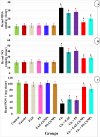Chitosan nanoencapsulation of Turbinaria triquetra metabolites in the management of podocyturia in nephrotoxic rats
- PMID: 39753630
- PMCID: PMC11698862
- DOI: 10.1038/s41598-024-82463-y
Chitosan nanoencapsulation of Turbinaria triquetra metabolites in the management of podocyturia in nephrotoxic rats
Abstract
Cisplatin is a chemotherapeutic drug, which exhibits undesirable side effects. Chitosan nanoparticles are promising for drug delivery. The aim of this study was to determine the effect of the brown alga Turbinaria triquetra ethyl acetate fraction and polysaccharides, either loaded on chitosan nanoparticles or free, against podocyturia and cisplatin nephrotoxicity in rats. Sixty-six male rats were distributed into 11 equal groups: untreated control, chitosan (CSNPs), ethyl acetate fraction (EAE), polysaccharide (PS), EAE loaded on chitosan nanoparticles (EAE-CSNPs), PS loaded on chitosan nanoparticles (PS-CSNPs), Cisplatin or cis-diamminedichloroplatinum(II) (CDDP), CDDP + EAE, CDDP + PS, CDDP + EAE-CSNPs, and CDDP + PS-CSNPs. Serum urea, creatinine, creatinine clearance, renal malondialdehyde, nitric oxide, paraoxonase 1, renal nephrin, and podocin, and their renal mRNA gene expressions, as well as urinary nephrin and podocin were determined. The results indicated that the ethyl acetate fraction and polysaccharides, either free or loaded, efficiently attenuated podocyturia and cisplatin nephrotoxicity compared to the Cis group. However, the improvement was higher in the nephrotoxic groups treated with EAE-CSNPs and PS-CSNPs. The current study revealed that chitosan nanoencapsulation showed ameliorative effects against podocyturia and cisplatin nephrotoxicity in rats compared to free extracts, offering a new therapeutic strategy for attenuating podocyturia and CDDP-induced nephrotoxicity.
Keywords: Turbinaria Triquetra; Brown alga; Chitosan nanoparticles; Cisplatin; Nephrotoxicity; Podocyturia; Polysaccharide.
© 2024. The Author(s).
Conflict of interest statement
Declarations. Compliance with ethical standards: This work was approved by the Institutional Animal Ethics Committee (Code No: Sci-Ch-M-2021-99: dated 24.05.2021), Mansoura University, Mansoura, Egypt. All the procedures in this study were in accordance with the national laws. Competing interest: The authors have no relevant financial or non-financial interests to disclose.
Figures








References
-
- Kabir, M. T., Rahman, M. H., Shah, M., Jamiruddin, M. R., Basak, D., Al-Harrasi, A.,… Abdel-Daim, M. M. Therapeutic promise of carotenoids as antioxidants and anti-inflammatory agents in neurodegenerative disorders. Biomedicine & Pharmacotherapy 2022, 146, 112610. https://doi.org/10.1016/j.biopha.2021.112610 - PubMed
Publication types
MeSH terms
Substances
LinkOut - more resources
Full Text Sources

